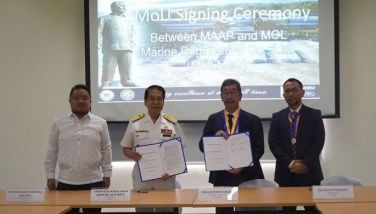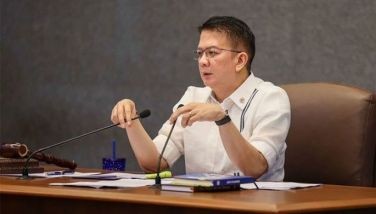Abu Sayyaf behind Zambo blast—GMA
November 2, 2001 | 12:00am
Don’t look now but it’s still the Abu Sayyaf.
President Arroyo believes that the recent spate of bombings in Zamboanga City was the handiwork of the Muslim extremist group and has no connection with the al-Qaeda network of international terrorist Osama bin Laden.
"Apparently not, according to (Philippine National Police chief, Director) General (Leandro) Mendoza," the President told reporters when asked if she believes the bombings were instigated by an alleged local cell of the notorious terrorist group.
The President likewise congratulated the PNP, the National Bureau of Investigation and the Armed Forces for arresting three suspects for the Oct. 28 bombing of a food plaza in downtown Zamboanga that left five people dead and 47 others wounded. One of the suspects admitted making the bombs that were exploded in three budget hotels on Oct. 7.
Mendoza said the arrests of the three suspects also averted a purported plan to bomb vital installations in Metro Manila and that the authorities have conducted "bomb sweeps" of the supposed targets.
National Security Adviser Roilo Golez, for his part, dismissed the reported links with al-Qaeda as mere speculations.
"Everything is being validated but we can’t think of any al-Qaeda connection," Golez told The STAR, adding that the speculations emerged after pictures of Bin Laden were found in the possession of one of three suspects arrested for the Zamboanga City bombings.
"But you see, it’s fashionable nowadays to have pictures of Bin Laden which anybody can get. They’re a dime a dozen these days but it doesn’t mean they are connected with al-Qaeda," Golez said. Golez noted that one of the arrested suspects, Habibullah Sahibul, was identified as a member of the Abu Sayyaf group against which the military is conducting heightening pursuit operations.
The Abu Sayyaf, which is still holding two American and nine Filipino hostages, has claimed links with the al-Qaeda since its slain founder supposedly knows Bin Laden and his brother-in-law Mohammed Khalifa.
"(But) we don’t see any of their possible connection with the al-Qaeda. Our conclusion is there is no indication that would make us believe there is any connection with the al-Qaeda," Golez stressed.
"But we’re not taking any chances as usual. We are digging deeper if there are other group members," Golez added.
PNP Intelligence Group director Chief Superintendent Robert Delfin confirmed they are tracking down at least two more suspects in the Oct. 28 food plaza bombing and expect more arrests soon.
Golez noted that the PNP believes it has busted this group of local terrorists.
"This group showed how vicious and brutal they are. The bombers did not care whether their victims are Muslims or Christians. They are indiscriminate in their targets," Golez noted.
According to the police, the suspects allegedly left a can packed with a kilogram of explosives at one of the eateries at the Zamboanga Puericulture Center along Purisima Street at about 8 p.m. of Oct 28.
Police said potassium nitrate was the explosive likely used, spiked with nails of different sizes. The type of bomb was a high order detonation, bomb experts said.
Upon seeing the can, a shopkeeper became suspicious and asked a security guard, identified as Isnin Asner Sultan, to report it to the police but the guard decided to shake the can, causing it to explode.
Aside from Sultan, police identified the four other fatalities as Cathy Cordita, 9, Jimmy Olias, Gerard Manzo and a still unidentified man.
The powerful explosion also damaged the ceilings of two stalls in the food plaza, blasted the concrete fence and created a two-ft. wide and one-ft. deep crater.
Minutes after the explosion, the bomb squad also defused another bomb in front of the Chowking fast-food restaurant.
Authorities suspect that the Abu Sayyaf masterminded the bombing to force the military to shift focus from its operations in nearby Basilan island.
Police later arrested the three suspects: Marvin Geonzon, alias Abdulmalik bin Geonzon, 27; Rodel Ladrera, alias Jamal; and Habibulla Sahibul.
Geonzon is supposedly a scion of a wealthy family from Davao City and studied biochemistry at the University of the Philippines.
He was arrested by a joint team of police, military and NBI agents at Barangay Caragayon near Zamboanga City while Ladrera was arrested at the Zamboanga Central Market and Sahibul at the Zamboanga port.
Geonzon claimed to be part of a 40-man terrorist cell established and trained by al-Qaeda and that they already have members in Metro Manila to conduct further bombing missions.
Geonzon also admitted he personally made the bombs that exploded at budget hotels Imperia, Paradise and Platinum in Zamboanga City. The bombs exploded and caused damage to the properties but there were no injuries.
Authorities seized from Geonzon a diary that contains 13 names of the group’s supposed al-Qaeda financiers. They also seized bomb ingredients and devices similar to the one used in the food plaza bombing.
Also seized were documents indicating the group was planning to bomb at least three posh hotels in Makati City, the Manila international and domestic airports, the fuel depot at Pandacan, Manila and upscale shopping malls.
The suspects also supposedly planned to plant bombs in open manholes and gutters located in crowded places in the metropolis.
The police also arrested in Davao City a suspected terrorist who was severely injured when the bomb he was supposed to plant at a building of the Southern Philippines Development Authority (SPDA) blew up prematurely.
Now confined at a undisclosed hospital in Davao City for massive head and body injuries is Najeeb Rasul Fernandez, who allegedly tried to plant a homemade bomb at the SPDA guest house.
It was not immediately clear, however, if Fernandez was connected to the three men who were arrested for the Zamboanga City food plaza bombing. — Marichu Villanueva, Christina Mendez
President Arroyo believes that the recent spate of bombings in Zamboanga City was the handiwork of the Muslim extremist group and has no connection with the al-Qaeda network of international terrorist Osama bin Laden.
"Apparently not, according to (Philippine National Police chief, Director) General (Leandro) Mendoza," the President told reporters when asked if she believes the bombings were instigated by an alleged local cell of the notorious terrorist group.
The President likewise congratulated the PNP, the National Bureau of Investigation and the Armed Forces for arresting three suspects for the Oct. 28 bombing of a food plaza in downtown Zamboanga that left five people dead and 47 others wounded. One of the suspects admitted making the bombs that were exploded in three budget hotels on Oct. 7.
Mendoza said the arrests of the three suspects also averted a purported plan to bomb vital installations in Metro Manila and that the authorities have conducted "bomb sweeps" of the supposed targets.
National Security Adviser Roilo Golez, for his part, dismissed the reported links with al-Qaeda as mere speculations.
"Everything is being validated but we can’t think of any al-Qaeda connection," Golez told The STAR, adding that the speculations emerged after pictures of Bin Laden were found in the possession of one of three suspects arrested for the Zamboanga City bombings.
"But you see, it’s fashionable nowadays to have pictures of Bin Laden which anybody can get. They’re a dime a dozen these days but it doesn’t mean they are connected with al-Qaeda," Golez said. Golez noted that one of the arrested suspects, Habibullah Sahibul, was identified as a member of the Abu Sayyaf group against which the military is conducting heightening pursuit operations.
The Abu Sayyaf, which is still holding two American and nine Filipino hostages, has claimed links with the al-Qaeda since its slain founder supposedly knows Bin Laden and his brother-in-law Mohammed Khalifa.
"(But) we don’t see any of their possible connection with the al-Qaeda. Our conclusion is there is no indication that would make us believe there is any connection with the al-Qaeda," Golez stressed.
"But we’re not taking any chances as usual. We are digging deeper if there are other group members," Golez added.
PNP Intelligence Group director Chief Superintendent Robert Delfin confirmed they are tracking down at least two more suspects in the Oct. 28 food plaza bombing and expect more arrests soon.
Golez noted that the PNP believes it has busted this group of local terrorists.
"This group showed how vicious and brutal they are. The bombers did not care whether their victims are Muslims or Christians. They are indiscriminate in their targets," Golez noted.
According to the police, the suspects allegedly left a can packed with a kilogram of explosives at one of the eateries at the Zamboanga Puericulture Center along Purisima Street at about 8 p.m. of Oct 28.
Police said potassium nitrate was the explosive likely used, spiked with nails of different sizes. The type of bomb was a high order detonation, bomb experts said.
Upon seeing the can, a shopkeeper became suspicious and asked a security guard, identified as Isnin Asner Sultan, to report it to the police but the guard decided to shake the can, causing it to explode.
Aside from Sultan, police identified the four other fatalities as Cathy Cordita, 9, Jimmy Olias, Gerard Manzo and a still unidentified man.
The powerful explosion also damaged the ceilings of two stalls in the food plaza, blasted the concrete fence and created a two-ft. wide and one-ft. deep crater.
Minutes after the explosion, the bomb squad also defused another bomb in front of the Chowking fast-food restaurant.
Authorities suspect that the Abu Sayyaf masterminded the bombing to force the military to shift focus from its operations in nearby Basilan island.
Police later arrested the three suspects: Marvin Geonzon, alias Abdulmalik bin Geonzon, 27; Rodel Ladrera, alias Jamal; and Habibulla Sahibul.
Geonzon is supposedly a scion of a wealthy family from Davao City and studied biochemistry at the University of the Philippines.
He was arrested by a joint team of police, military and NBI agents at Barangay Caragayon near Zamboanga City while Ladrera was arrested at the Zamboanga Central Market and Sahibul at the Zamboanga port.
Geonzon claimed to be part of a 40-man terrorist cell established and trained by al-Qaeda and that they already have members in Metro Manila to conduct further bombing missions.
Geonzon also admitted he personally made the bombs that exploded at budget hotels Imperia, Paradise and Platinum in Zamboanga City. The bombs exploded and caused damage to the properties but there were no injuries.
Authorities seized from Geonzon a diary that contains 13 names of the group’s supposed al-Qaeda financiers. They also seized bomb ingredients and devices similar to the one used in the food plaza bombing.
Also seized were documents indicating the group was planning to bomb at least three posh hotels in Makati City, the Manila international and domestic airports, the fuel depot at Pandacan, Manila and upscale shopping malls.
The suspects also supposedly planned to plant bombs in open manholes and gutters located in crowded places in the metropolis.
The police also arrested in Davao City a suspected terrorist who was severely injured when the bomb he was supposed to plant at a building of the Southern Philippines Development Authority (SPDA) blew up prematurely.
Now confined at a undisclosed hospital in Davao City for massive head and body injuries is Najeeb Rasul Fernandez, who allegedly tried to plant a homemade bomb at the SPDA guest house.
It was not immediately clear, however, if Fernandez was connected to the three men who were arrested for the Zamboanga City food plaza bombing. — Marichu Villanueva, Christina Mendez
BrandSpace Articles
<
>
- Latest
- Trending
Trending
Latest
Trending
Latest
Recommended
February 20, 2025 - 12:00am



























